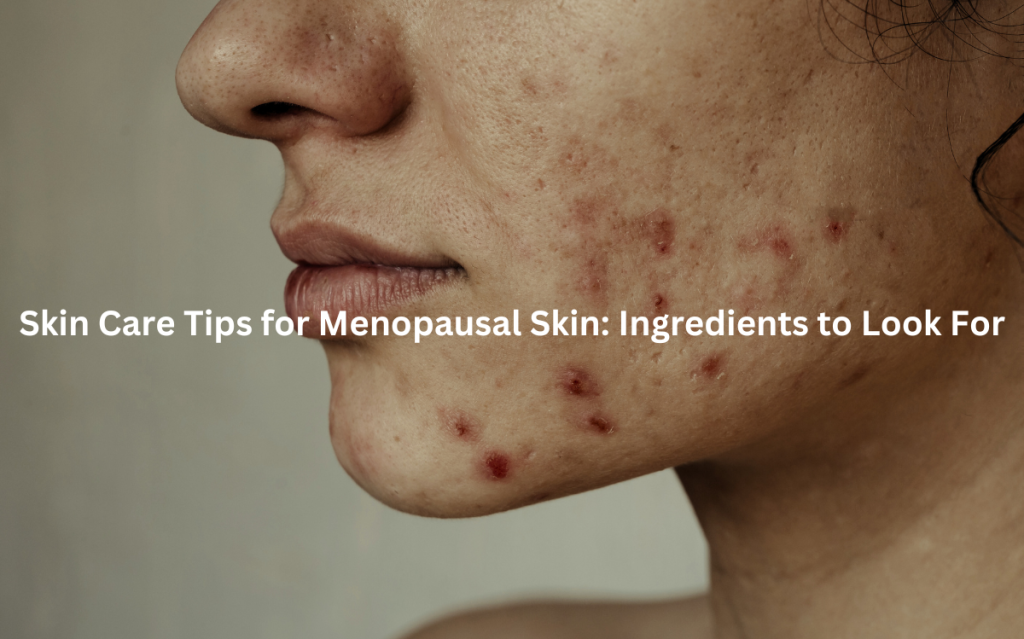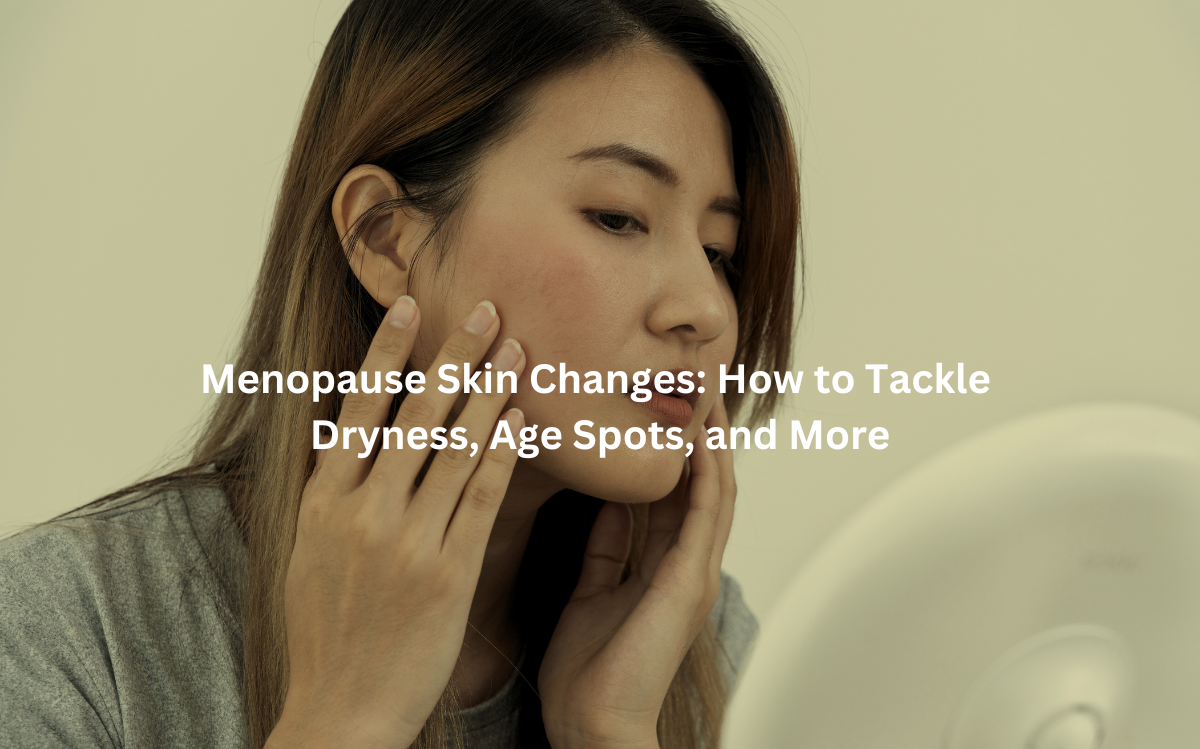Learn how menopause affects your skin and get actionable tips to manage dryness, wrinkles, and pigmentation changes.
As menopause sets in, hormonal fluctuations can cause noticeable changes in your skin. From dry patches to age spots and thinning skin, the transition can be frustrating. (1)
But understanding these changes and adjusting your skincare routine can help you maintain healthy, glowing skin throughout menopause.
Key Takeaways
- Hydration is Key: Menopausal skin loses moisture, so investing in hydrating skincare products is essential for maintaining smooth, soft skin.
- Sun Protection: Menopausal skin is more sensitive to sun damage, making daily sun protection vital to prevent age spots and further damage.
- Targeted Treatments: Use products with hyaluronic acid and salicylic acid to address dryness, acne, and hyperpigmentation caused by hormonal shifts.
Menopause Skin Changes: Key Factors and Symptoms
Menopause can feel like a rollercoaster, not just for emotions but for the skin too. As women enter menopause, the sharp drop in estrogen levels triggers a range of skin changes. Estrogen, the body’s main sex hormone, plays a vital role in keeping skin plump and hydrated. (2)
- Dry Skin: As estrogen declines, the skin starts losing moisture more easily. This often leads to dryness and a rough texture.
- Reduced Elasticity: Collagen production also decreases, making the skin feel thinner and more fragile.
But the changes don’t stop there. Some women experience darker spots on their skin.
- Dark Spots: Known as age spots or sun spots, these are more likely to appear due to a slower skin regeneration process and increased melanin production caused by hormonal imbalances.
Another surprising issue during menopause is acne.
- Acne: Many women find that acne reappears in middle age. A spike in androgens (male hormones) leads to increased oil production and clogged pores.
Lastly, facial hair growth can become noticeable.
- Facial Hair: As estrogen levels drop, testosterone can take over, causing unwanted hair growth, particularly on the chin or upper lip.
These changes are all part of the natural process of menopause, but they can still be difficult to navigate.
Understanding Dry Skin and Itchy Skin During Menopause
The moment the air hits your skin, it’s like your body is whispering, “You’re losing moisture, fast.” Menopausal women often describe their skin as feeling dry, tight, and even itchy.
Why? Well, as estrogen decreases, so does the skin’s ability to retain moisture. Collagen, which keeps the skin firm and resilient, also declines, leading to skin that feels thinner and rougher.
Collagen is essential for your skin’s structure, and without enough of it, the skin becomes less elastic, leading to more noticeable wrinkles. But that’s not all—this combination of dryness and lack of collagen can make the skin more prone to irritation and itching.
To manage this, hydration is key. Drinking plenty of water can help keep skin hydrated from the inside out. Topically, you’ll want to use moisturizers that focus on hydration, like those containing hyaluronic acid or glycerin. Also, go for gentle cleansers.
The harsher, foamy ones can strip away natural oils, making things worse. A good rule of thumb? Skip anything with alcohol in it, as it can dry out your skin even more. Regular moisturizing, especially right after showering when your skin is still damp, can lock in moisture.
Age Spots and Hyperpigmentation: What Happens to Your Skin?
As the years pass, so does our skin’s ability to bounce back from sun damage. This might be why those dark spots or uneven pigmentation seem to sneak up on many women in their 40s and 50s.
When estrogen drops, the skin becomes more vulnerable to sun damage. This can make the skin more prone to hyperpigmentation, and areas that have been exposed to the sun tend to darken over time.
The rise of melanin production during menopause is another factor here. The skin just doesn’t have the same ability to evenly distribute pigment, which leads to age spots. While these are harmless, they can be a cosmetic concern for many.
There are treatments available to help lighten these spots. Topical treatments containing ingredients like vitamin C, niacinamide, and retinoids can help to fade hyperpigmentation over time.
Also, wearing sunscreen daily (yes, even when it’s cloudy) is the first line of defense against making the problem worse. A broad-spectrum SPF 30 or higher will help protect the skin from further damage.
Hair Loss and Thinning Skin During Menopause
If menopause didn’t already come with enough surprises, add hair thinning to the list. As estrogen declines, testosterone—though present in smaller amounts in women—can begin to have a stronger effect. This can lead to thinning hair, especially around the crown.
In fact, a lot of women start noticing more hair in their brushes and showers during this time. It’s not just the hair, either. Thinning skin can make the scalp more noticeable, which adds to the issue.
Luckily, there are ways to manage both hair loss and thinning skin. A well-balanced diet rich in vitamins and minerals (think B vitamins, biotin, and zinc) can encourage healthy hair growth.
Supplements can help too. Some women find that collagen supplements or topical treatments designed to boost hair thickness can make a difference. For skin, maintaining hydration is crucial. Collagen-boosting ingredients like peptides or retinol in skincare can help maintain skin strength and resilience.
Sun Protection: Essential for Menopausal Skin Health
Sun exposure, especially after menopause, is something to pay extra attention to. With estrogen levels on the decline, the skin becomes more vulnerable to sun damage. You might find yourself burning faster, and it takes longer to heal. Menopausal skin is thinner and more prone to pigmentation issues, which makes sun protection even more important.
Wearing sunscreen every day is non-negotiable. It’s best to go for a broad-spectrum sunscreen with at least SPF 30.
Hats, sunglasses, and even protective clothing can help shield the skin from harmful UV rays. It’s not just about avoiding burns; it’s about maintaining skin health long-term.
On the flip side, there’s something to be said about vitamin D, which is often associated with sunlight. While protecting your skin, make sure you’re still getting enough vitamin D, as it’s crucial for bone health during menopause. If you’re worried about not getting enough, vitamin D supplements are an easy way to ensure your levels stay up.
Skin Care Tips for Menopausal Skin: Ingredients to Look For

Choosing the right products for menopausal skin can make a world of difference. Focus on hydrating and rejuvenating ingredients like hyaluronic acid, which can hold up to 1,000 times its weight in water, and peptides that help restore skin’s structure. Collagen-boosting ingredients like retinoids can also be great for thickening the skin and reducing wrinkles.
Gentle, hydrating cleansers are crucial, as harsher ones can strip away what little moisture your skin has. Follow up with a good moisturizer to lock it all in. Avoid over-exfoliating, too. While exfoliating can help get rid of dead skin cells, overdoing it can irritate menopausal skin and worsen dryness.
Also, consider adding a facial oil if your skin is particularly dry. Oils like rosehip, argan, or jojoba can be great for sealing in moisture and giving your skin a dewy finish.
Hormone Replacement Therapy (HRT) and Its Effects on Skin Health
Hormone Replacement Therapy (HRT) is one of the most talked-about solutions for managing menopause symptoms. HRT can do wonders for skin, improving its moisture levels, elasticity, and even helping to prevent wrinkles. For women who choose to go down this route, HRT can replenish estrogen, which boosts collagen production, and might make your skin feel firmer and more hydrated.
However, HRT isn’t without its potential downsides. Some women report side effects like bloating, headaches, or mood swings.
On the skin front, there’s also the possibility that it could cause breakouts or pigmentation changes, depending on the type of hormone therapy and the woman’s body. Always consult a healthcare professional before starting HRT, as they’ll help weigh the pros and cons based on individual health factors.
Skin Conditions During Menopause: When to Seek Medical Help
Menopausal skin changes are common, but there are certain skin conditions that require professional attention. If your skin becomes excessively dry, irritated, or develops a rash, it’s worth consulting with a dermatologist.
In some rare cases, skin cancer or other serious conditions might present with symptoms that seem like ordinary menopause skin changes. If you notice any unusual moles, spots that change color, or bleeding, it’s important to see a doctor right away.
Conditions like hidradenitis suppurativa (a painful skin disorder that causes lumps and abscesses) can also flare up during menopause due to hormonal changes. This is something that a healthcare provider should assess for proper treatment.
Conclusion
Managing skin during menopause is all about maintaining hydration, using the right skincare products, and protecting the skin from external factors like the sun. While menopause brings skin challenges, there are plenty of ways to fight back.
Hydrate inside and out, choose gentle yet effective products, and get professional advice when needed. Whether you opt for HRT or not, keeping your skin nourished, protected, and balanced can make all the difference during this phase of life.
If skin changes are impacting your confidence, book a consultation with Modern Menopause today to get expert advice and support. Book here.
FAQ
What are the common skin changes during menopause?
During menopause, the decline in estrogen can lead to skin becoming thinner, drier, and less elastic. Reduced collagen production contributes to wrinkles, and some women may experience increased skin sensitivity. Moisturizers and hydrating serums can help manage dryness, while gentle skincare routines may minimize irritation.
How can menopause affect acne and breakouts?
Hormonal fluctuations during menopause can cause acne to flare up, particularly around the chin and jawline. The decrease in estrogen and rise in androgen hormones may stimulate oil production, leading to clogged pores. Using non-comedogenic products and maintaining a consistent skincare routine can help manage these breakouts.
Can menopause cause changes in skin tone and pigmentation?
Yes, menopause can result in uneven skin tone and pigmentation issues, such as age spots or melasma. The drop in estrogen levels can cause the skin to produce more melanin, leading to hyperpigmentation. Sun protection and brightening skincare ingredients like vitamin C can help address these concerns.
Are there any treatments for menopause-related skin changes?
Moisturizing regularly, using products with antioxidants, and applying sunscreen daily can help mitigate skin changes during menopause. Some women may also benefit from hormone replacement therapy (HRT) or topical treatments that promote collagen production. Consulting a dermatologist for personalized care is a good option.
Is it possible to improve skin elasticity during menopause?
Yes, while skin elasticity naturally declines with age, there are ways to improve it during menopause. Topical treatments with retinoids, peptides, or hyaluronic acid can promote collagen production. Additionally, staying hydrated, eating a balanced diet, and practicing good skincare can help maintain skin’s firmness and elasticity.
References
- https://pmc.ncbi.nlm.nih.gov/articles/PMC10092853/
- https://thebms.org.uk/wp-content/uploads/2023/08/17-BMS-TfC-What-is-the-menopause-AUGUST2023-A.pdf

Leave a Reply